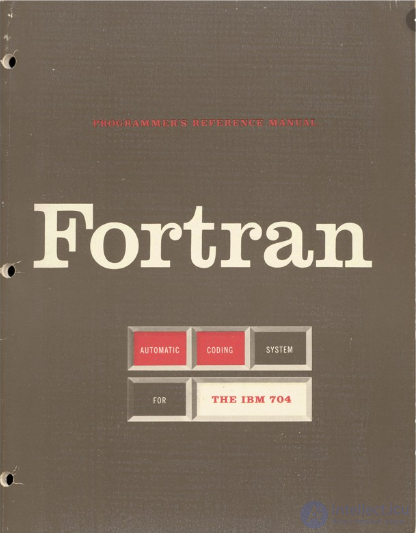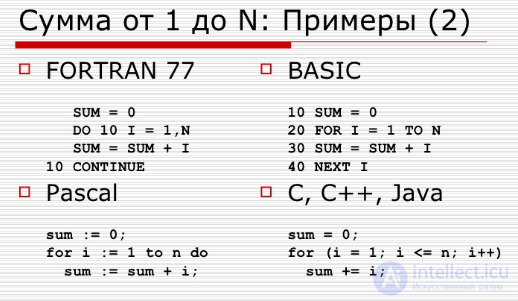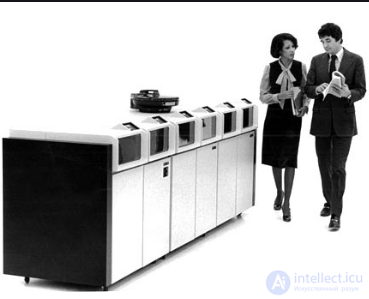Lecture
At the end of the article, we would like to give a short list of the most serious discoveries made by IBM during its existence, but not mentioned above. After all, it is always a pleasure to once again be amazed that one or another well-known company is behind the creation of another favorite electronic toy.
The beginning of the era of high-level programming languages is attributed to IBM. Well, maybe not to her personally, but she took a very active part in this process. In 1954, the IBM 704 computer was introduced, one of the main “chips” of which was support for the Fortran language (short for Formula Translation). The main purpose of its creation was to replace the low-level assembly language with something more readable to humans.


Fortran
In 1956, the first Fortran reference guide appeared. And in the future, his popularity continued to grow. Mainly due to the inclusion of a language translator in the standard IBM software package. This language has become the main for scientific applications for many years, and also gave impetus to the development of other high-level programming languages.
About IBM's contribution to the development of databases, we have already mentioned. In fact, thanks to the blue giant, most of the sites on the Internet that use relational databases work today. Do not hesitate to use the language of SQL, which also came from the depths of IBM. In 1974, he was represented by employees of the company Donald Chamberlin (Donald D. Chamberlin) and Raymond F. Boyce. It was then called SEQUEL (Structured English Query Language), and after the abbreviation was reduced to SQL (Structured Query Language), because "SEQUEL" was a trademark of the British airline Hawker Siddeley.
Probably, some still remember how they started playing games from tape recorders on their home (or not home) computer of the EU. But IBM was one of the first to use magnetic tape for data storage. In 1952, together with the IBM 701, she introduced the first magnetic tape drive that could write and read data.
Floppy disks also appeared thanks to IBM. In 1966, she introduced the first drive with a metal recording head. Five years later, she announced the beginning of the mass distribution of floppy disks and drives for them.
IBM 3340 "Winchester"


The slang word "hard drive", meaning hard disk, also originated from the bowels of IBM. In 1973, the company introduced the hard disk IBM 3340 "Winchester". It received its name from the head of the development group Kenneth Hogton (Kenneth Haughton), who assigned the IBM 3340 internal name "30-30", derived from the name of the rifle Winchester 30-30. "30-30" directly indicated the capacity of the device - two plates of 30 MB each were installed in it. By the way, this model was the first to receive a great commercial success in the market.
It is necessary to thank IBM and for our modern memory. It was she who in 1966 invented the technology of production of dynamic memory, where only one transistor was allocated for one bit of data. As a result, we managed to significantly increase the data recording density. Probably, this discovery prompted the company's engineers to create a special ultra-fast data buffer or cache. In 1968, this was first implemented in the System / 360 Model 85 mainframe and could store up to 16 thousand characters.
The architecture of the PowerPC processors also came about thanks to IBM. And although it was developed jointly by Apple, IBM and Motorola, it was based on the IBM 801 processor, which the company planned to install on its first personal computers in the early 80s. At first, the architecture was supported by Sun and Microsoft. However, other developers did not seek to write programs for it. As a result, Apple has remained its only user for almost 15 years.
In 2006, Apple abandoned PowerPC in favor of the x86 architecture, and in particular, Intel processors. Motorola withdrew from the alliance in 2004. Well, but IBM still didn’t roll back its development, but sent them in a somewhat different direction. A few years ago, there was written so much text about the Cell processor that it would be enough for several books. Today, it is used in the Sony PlayStation 3, and Toshiba has installed its simplified version in its flagship multimedia notebook Qosmio Q50.
On this, perhaps, we round out. If you wish, you can find many other amazing discoveries of IBM, and at the same time write a lot of words about its future projects, but then you should already start to make a separate book. After all, the company conducts research in various fields. She has hundreds of active projects, among which there are such as nanotechnologies and holographic data carriers, speech recognition, communication with a computer with the help of thoughts, new ways to control a computer, and so on - one page will take several pages of text. So on this we put an end.
PS And at the very end there is a little bit about the origin of the term "blue giant" (or "BigBlue"), as IBM is often called. As it turned out, the company itself has nothing to do with it. Products with the word "Blue" in its name appeared only in the 90s (particularly in the supercomputer series), and the "blue giant" press has been calling it since the early 80s. IBM officials suggest that this could have come from the blue cover of its mainframes that were produced in the 60s.
Comments
To leave a comment
History of computer technology and IT technology
Terms: History of computer technology and IT technology